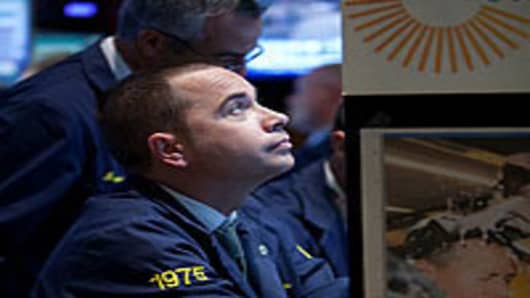Call it being complacent over complacency—redundant for sure, but an expression of how even a healthy level of fear has seemed to come completely out of the stock market.
As the stock market has churned to two-year highs, sentiment levels as expressed through a variety of gauges have reflected extremely buoyant attitudes among investors. Surveys from Investors Intelligence and the American Association of Individual Investors both show bullish sentiment more than 2 to 1 ahead of market pessimism.
Similarly, the CBOE Volatility Index , an options play that is considered a gauge of near-term fear (when it's elevated) and complacency (when it's falling), has been hovering around levels last seen in April.
So with a 9.8 percent unemployment rate, the housing market continuing to flail, and European debt concerns likely only pushed off for another day, isn't anybody worried that the massive 19-month stock rally could come undone?
"The need to defend against adverse stock market movement is becoming less and less all the time," Andrew Wilkinson, senior strategist at Interactive Brokers, says of the low VIX levels. "The reality is there's no double-dip ahead of us for 2011, therefore the perceived need for taking protection against risk is lower all the time."
The bullishness, however, doesn't necessarily mean that stocks are poised for a huge rally or that retail investors—who fled the market duing the financial crisis—are ready to jump back in.
Those who worry that bullish sentiment is getting too frothy also might point to the VIX chart and note that the last time the measure was this low, it preceded a brutal market dip through the summer precpitated by Europe's sovereign debt crisis.
But the market seems eager to disregard such worries, at least so far as sentiment about where the market is headed is concerned. Strategists have been upping their forecastsfor 2011 with numbers that reflect gains of 10 to 20 percent or more in the Standard & Poor's 500.
Irrational exuberance considering the headwinds? Maybe, but few seem to care at this point.
"Certainly there is complacency everywhere, to the point where the bears just can't take control," says Kathy Boyle, president of Chapin Hill Advisors in New York and a long-time market bear herself. "Even though we're extremely bearish, you've got to go with the flow."
At least one reason why the market optimists aren't worried about sentiment going overboard is the flow of funds.
Despite the market's surge—11 percent in 2011 and 85 percent since the March 2009 lows—bond funds are experiencing only modest outflows and equity fund inflows remain weak. In fact, low-yielding money market funds actually saw a slight inflow for the week ended Dec. 8, with the total now for so-called "money on the sidelines" at $2.835 trillion, according to the Investment Company Institute.
"You have to look at sentiment in conjunction with mutual fund flows," says Liz Ann Sonders, chief investment strategist at Charles Schwab in San Francisco. "We have not seen anywhere near the bullish fund flows into equities consistent with the optimism that is being expressed within the sentiment surveys."
Sonders notes that the most of the surveys are "attitudinal" rather than measures of where money is going, so bullishness expressed in them "probably makes the market a little bit more vulnerable to something—any kind of negative news—but I'd be much more concerned if we were seeing the kind of" fund flows consistent with over-exuberance.
Still, the danger exists that another unexpected event could set the market on its ear.
The market has, in addition to the VIX, a variety of other volatility products to help investors protect against turbulence. They include the iPath S&P 500 VIX Short-Term and the iPath S&P 500 VIX Mid-Term Futures , exchange-traded notes that track longer timelines than the VIX.
"The desire for insurance is still there, even if the VIX itself doesn't seem to show it," Nicholas Colas, chief market strategist at BNY ConvergEx in New York, wrote in a note to clients. "Whether this creeps back into VIX pricing in the New Year remains to be seen, but with the cost of insurance so cheap it seems worthwhile to buy protection even if markets are dismissing the threat of a storm."
Options activity on the VIX has been faily muted, though there has been some movement from traders looking to get protection several months down the road.
"It's all about the economic numbers," Tim Freeman, of Capstone Global Markets, said in a CNBC interview. "The market is very, very confident those numbers will come in OK over the next three months, and they're very worried about it over the next six months."
Indeed, things can change quickly in such a shaky economy.
Back in August of 2008, the VIX was trading around 18. Two months later—after the collapse of Lehman Brothers—the gauge eclipsed its all-time high past 80.
"[B]eneath the price surface, volume is tepid, the leadership board is starting to fade and the NYSE advance-decline line is looking a tad troubling," David Rosenberg, economist and strategist at Gluskin Sheff in Toronto, noted in his daily analysis. "All this nagging technical stuff does not usually begin to resonate until the inevitable correction takes hold."



